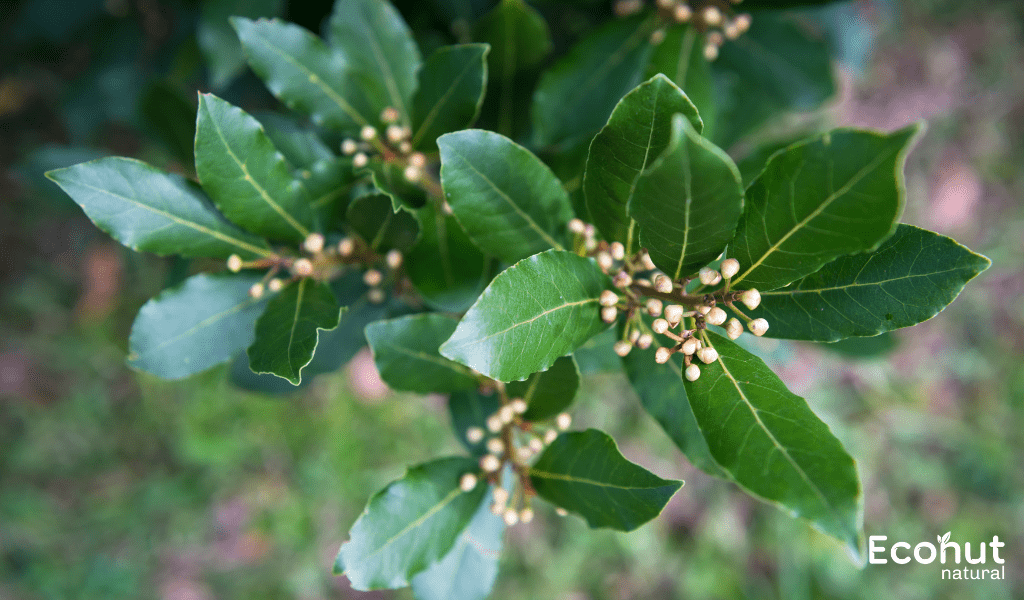Bay leaves (Laurus nobilis) is an aromatic evergreen tree or large shrub native to the Mediterranean region. It belongs to the family Lauraceae and is widely cultivated for its culinary and ornamental uses.
Discription:
The bay laurel is dioecious (unisexual), with male and female flowers on separate plants. Each flower is pale yellow-green, about 1 cm diameter, and they are borne in pairs beside a leaf.
The leaves are glabrous, 6–12 cm (2–5 in) long and 2–4 cm broad, with an entire (untoothed) margin. On some leaves the margin undulates. The fruit is a small, shiny black drupe-like berry about 1 cm long that contains one seed.
Regional Names of Bay leaves (Laurus nobilis)
English name-Lignea, Bay leaf, India Cassia
Hindi name- Tejpat
Tamil name- Lavangapatri
Telugu name-Akupatri
Danish name- IndishLaurbareblad
Assamese name- Tejpat, Mahpat
Gujarati name- TamalaPatra, Develee
Bengali name- Tejpatra, Tejpata
Kannada name- DalchiniEle, Tamalapatra
Kashmiri name- Dalchini pan, Tajpatra
Marathi name- Tamalpatra
Oriya name- Tejapatra
Punjabi name- Tajapter
Urdu name- Tezpat
Finnish name- Lauries des Indes
German name- IndischesLorburblatt
Japanese name- Tamara-nikkei, Tezipatto
Hungaraian name- Indiaibaberlevel
Burmese name- Thitchabo, Thitkyabo
Scientific Classification
| Kingdom | Plantae |
| Subkingdom | Tracheobionta |
| Order | Fabales |
| Family | Leguminosae |
| Subfamily | Caesalpinaceae |
| Superdivision | Spermatophyta |
| Division | Magnoliophyta |
| Class | Magnoliopsida |
| Subclass | Rosidae |
| Genus | Saraca |
| Species | Asoca / Indica |
Ayurvedic Properties
Hindi / Sanskrit
- Rasa, Katu, Madhura
- Guna, Laghu, Tikshna, Picchila
- Veerya, Ushna
- Vipaka, Katu
English
- Taste, Pungent and Sweet
- Physical Property, Light, Sharp, Slimy
- Potency, Hot
- Undergoes pungent taste conversion after digestion, Pungent
Benefits of Bay leaves (Laurus nobilis)
Bay leaves, derived from the aromatic bay laurel tree (Laurus nobilis), are not only used to add flavor and aroma to various dishes but also offer several health benefits. Here, We are discuss some benefits regarding bay leaves.
Stress Relief:
The aroma of bay leaves has a calming effect on the mind and body. Burning dried bay leaves or using bay leaf essential oil in aromatherapy can help reduce stress, anxiety, and promote relaxation.
Betters Blood Sugar Regulation:
Medical Science suggest that bay leaves may help regulate blood sugar levels. Compounds found in bay leaves can improve insulin sensitivity and lower blood glucose levels, which may be beneficial for individuals with diabetes or those at risk of developing the condition.
Helpful In Digestive Health:
Bay leaves contain enzymes that aid in digestion by breaking down proteins and promoting the efficient absorption of nutrients. They can help alleviate common digestive issues like bloating, gas, and indigestion.
Anti-inflammatory Elements:
This herb contain phytonutrients and essential oils that possess anti-inflammatory properties. They can help reduce inflammation in the body, making them beneficial for conditions like arthritis and other inflammatory disorders.
Involves Antibacterial and Antifungal Elements:
This herb possess antibacterial and antifungal elements, thanks to the presence of essential oils such as cineole and eugenol. These properties make bay leaves effective in combating various bacterial and fungal infections.
Rich in Antioxidants:
This herb are packed with antioxidants such as vitamin C, vitamin A, and various flavonoids. These help neutralize free radicals, which can prevent oxidative stress and lower the risk of chronic diseases like cancer and heart disease.
Use For Better Respiratory Health:
The essential oils present in bay leaves have expectorant properties, which can help relieve respiratory issues like congestion, coughs, and bronchitis. Inhaling the steam from boiling bay leaves can provide relief from respiratory discomfort.
Also Read: Kutuja, Kurchi (Holarrhena antidysenterica)
Side Effects of Bay leaves (Laurus nobilis)
Bay leaves (Laurus nobilis) are commonly used as a culinary herb to add flavor to various dishes. While they are generally safe for consumption, there are a few considerations regarding potential side effects.
Produce Allergic reactions:
Some peoples may be allergic to bay leaves. Symptoms of an allergic reaction can include itching, hives, swelling, difficulty breathing, and in severe cases, anaphylaxis.
Descreases Blood sugar levels:
There is some evidence to suggest that bay leaves may help lower blood sugar levels. While this can be beneficial for individuals with diabetes, it may interact with medications or other herbs that affect blood sugar levels. Therefore, individuals with diabetes should monitor their blood sugar levels closely when consuming bay leaves regularly.
Gastrointestinal System discomfort:
Consuming bay leaves in large quantities may lead to gastrointestinal discomfort such as nausea, vomiting, or diarrhea in sensitive individuals.
High Dosage May Toxic:
In rare cases, ingesting large amounts of bay leaves may lead to toxicity. This is more of a concern with concentrated bay leaf extracts or essential oils, rather than the whole leaves used in cooking.
Avoid During Pregnancy and Breastfeeding:
Pregnant and breastfeeding women should avoid consuming bay leaf extracts or supplements due to the lack of sufficient safety data.
Conclusion
Bay leaves (Laurus nobilis), renowned for their culinary and medicinal uses, stand as a testament to nature’s multifaceted bounty. With their rich history dating back to ancient times, these aromatic leaves have woven themselves into various cultural traditions worldwide. From enhancing the flavors of soups and stews to offering potential health benefits such as anti-inflammatory and digestive properties, bay leaves encapsulate both gastronomic delight and therapeutic potential.
FAQS
Do bay leaves have any health benefits?
This herb contain essential oils and compounds that may have some health benefits, including anti-inflammatory and antioxidant properties. They are also believed to aid in digestion and promote respiratory health, although more research is needed to confirm these effects.
Are there different varieties of bay leaves?
While Laurus nobilis is the most commonly used variety in cooking, there are other species of bay laurel that may have similar properties. However, Laurus nobilis is the one typically referred to as “bay leaf” in culinary contexts.
What do bay leaves taste like?
Bay leaves have a subtle, herbal flavor with hints of mint, eucalyptus, and clove. They add depth and complexity to dishes without overpowering other flavors.

